
Columbia, 15 Chapters, 1950. Starring Larry “Buster” Crabbe, Tommy Farrell, Lois Hall, Gene Roth, Tristram Coffin, Marshall Reed, Stanley Price, Hugh Prosser, Neyle Morrow.
Jeff Drake (Buster Crabbe), the captain of a schooner called the Ramble, reluctantly returns to the Pacific islands (where he served in the US Navy during World War Two) to help his war buddy Kelly Walsh (Tommy Farrell) battle some modern-day Pirates of the High Seas that have been plaguing Kelly’s shipping business on the island of Taluha. However, Kelly’s problems soon take a back seat to a treasure hunt for five million dollars’ worth of diamonds, the lost loot of a fugitive Nazi war criminal named Von Hausdorf. Jeff, Kelly, and Kelly’s sister Carol (Lois Hall) try to help the “United Peace Organization’s” agent Castell (Tristram Coffin) locate the stolen gems in the interests of justice, while the pirates’ secret leader Whitlock (Gene Roth)–also the owner and ruler of Taluha–sends his buccaneers in pursuit of the treasure, hoping to line his own pockets. An ivory cigarette box and a music box that plays “Three Blind Mice” both provide puzzling clues to the diamonds’ whereabouts, while the search is further complicated by taciturn ex-Navy expatriate Ben Wharton (William Fawcett), a trading-post proprietor called the Lotus Lady (Symona Boniface), and the mysterious Von Hausdorf himself.
Pirates of the High Seas constitutes a follow-up of sorts to Columbia’s 1947 serial The Sea Hound; although the characters are different, the two chapterplays have multiple actors in common, and both were largely filmed on Catalina Island. Pirates is by far the better serial, however; both serials benefit from Buster Crabbe’s presence in the lead, the Catalina locales, and a good supporting cast, but Pirates boasts sharper pacing and editing, superior direction, and better plotting.
Pirates’ writers–George Plympton, Charles Condon, Joseph Poland, and David Mathews–turn in some good work, pacing their script well and filling it with twists without making it unnecessarily complicated. The treasure-hunting plot unfolds gradually, with the audience and the characters encountering new clues simultaneously; the first chapter does an excellent job of establishing an aura of mystery, and the strategic introduction of new clues (the music box) or characters (Ben Wharton, Von Hausdorf) in subsequent chapters helps to keep this mysterious flavor strong.

Above: Buster Crabbe, Tommy Farrell, and Lois Hall puzzle over the ivory cigarette case.
The narrative does begin to sag a bit around Chapter Twelve (a curse common to fifteen-chapter serials from all studios), when Von Hausdorf’s true identity becomes obvious and the plot begins to devolve into a tug-of-war over the music box. The decoding of the box’s secret in Chapter Fourteen helps to get things back on track, however, while the climactic action in Chapter Fifteen–though too brief–is one of the more satisfying Columbia showdowns, since it directly involves the hero in the villains’ downfall instead of keeping him in the background while they eliminate each other. The writers dodge this common Columbia pitfall in earlier chapters as well, keeping the good guys at the center of the action while still giving full play to the large cast of heavies and quasi-heavies.
Another appealing facet of Pirates’ script is its unusually concrete sense of place and time; while Sea Hound’s milieu was never clearly identified, Pirates is firmly tagged as taking place in the Pacific through the many references to Drake and Walsh’s wartime service there. These references, together with the search for lost Axis spoil, make the chapterplay seem more realistic by tying it more firmly to its era than most 1950s serials. Pirates is not excessively realistic, however: nicely fantastic touches like the villains’ submersible pirate boat, Whitlock’s “radar board,” a creepy-looking masked witch doctor, and the disguised Von Hausdorf (who favors a Shadow-like cloak and hat get-up) keep the proceedings from ever becoming mundane.

Above: The pirate boat submerges itself, in a repeated but always nifty-looking piece of miniature work that all those first-run viewers of the serial seem to remember vividly.
Even if Pirates’ script was much weaker, the chapterplay would still benefit enormously from the Catalina locations, just as Sea Hound did before it. The island’s cliffs, beaches, hillsides, and bungalows provide just as much visual interest as in the earlier serial, while the depiction of Taluha as a fairly civilized island allows for utilization of some nifty winding island roads as well (these byways were kept off-screen in Hound, which supposedly took place on a more remote isle). Pirates also features more nautical sequences than Hound did; the pirates’ boat, Kelly Walsh’s freighter, and Drake’s schooner all figure in plenty of seagoing chases. As in Hound, all vessels are represented by actual ships and not studio sets.

Above: Terry Frost draws a bead on Tommy Farrell’s boat as the craft rests in a Catalina harbor.
Directors Thomas Carr and Spencer Bennet handle the action scenes skillfully, with Bennett’s flair for self-editing (he liked to “cut in the camera” while shooting serial footage) doing much to bring suspense and a sense of movement to fights or cliffhanger sequences; most of Katzman’s pre-Bennett serials (from the dark years of 1945-1948) were positively amateurish by comparison when it came to cutting and intercutting. The double fight on board Kelly’s boat in Chapter Two–shot from several different angles–is a particularly good example of Bennet’s expertise.
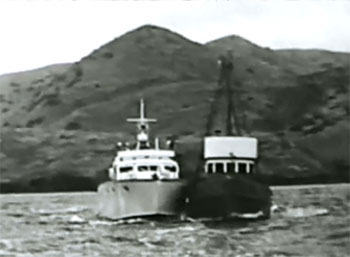
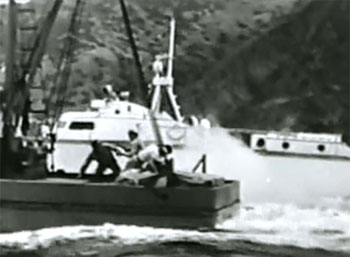

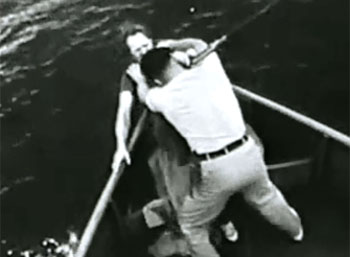
Above: Scenes from the boat chase, boarding, and subsequent fight in Chapter Two.
There are many other fights, chases, and shootouts–on land and sea–in Pirates. Chapter Five features a lengthy action sequence that begins with a fight in a shack, leads into a car chase, then becomes a foot chase through the Catalina hills and climaxes in a shootout sequence among seaside cliffs. The shipboard fight in Chapter Six is also good, as is the warehouse fight sequence in Chapter Nine–during which Buster Crabbe and Terry Frost toss and smash barrels and boxes in a fashion that recalls setpieces from director Bennet’s Republic serials. Other highlights Chapter Eight jailbreak sequence and the ambush in Chapter Eleven, both of which feature some good stuntwork.
The Chapter Eight jailbreak scene leads into one of the serial’s best chapter endings, in which Crabbe and Hugh Prosser–fighting on a jail wall being dragged behind a truck–tumble down a rocky cliff to their apparent doom. Most of the other cliffhangers, while generally unspectacular, are respectable enough–particularly Crabbe’s apparent squashing by a native execution device and the well-set-up ship fire sequence at the end of Chapter One. One cliffhanger (the Chapter Three ending) is lifted entirely from The Sea Hound, while another chapter-ending sequence borrows an idea (Crabbe being shot out of his ship’s rigging after a mast-head fight with a heavy) from Hound but improves upon it with superior camera angles–especially some great downward shots from the point of view of the men on the mast.
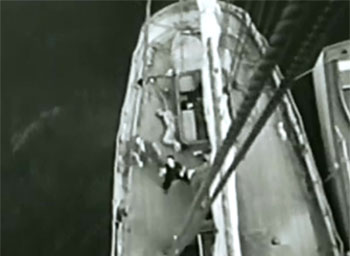
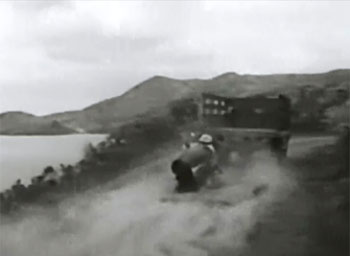
Above left: Marshall Reed (black shirt) draws a bead on the off-screen Buster Crabbe from the deck of the Ramble. Above right: Crabbe and Hugh Prosser take a wild ride behind a truck.
The serial’s actors seem to perform a fair share of the stuntwork themselves, although brief acting appearances by stuntmen Paul Stader (as a crooked sailor) and Charles Horvath (as a native) indicate that they had a hand in the action as well. According to the Internet Movie Database, George DeNormand and Eddie Parker also contributed; neither is visible on-screen, but both worked many times for Katzman, so their participation here is highly likely.
As for the aforementioned actors, they give just as good an account of themselves in the dialogue scenes as they do in the action ones. Buster Crabbe, in the tailor-made part of a tough and straightforward sea captain trapped in a maze of intrigue, is as commanding and as likable as ever–whether tossing gruff but good-natured barbs at sidekick Tommy Farrell, grimly growling “Hold it!” when he catches the villains up to mischief, or athletically springing into action.

Above: Buster Crabbe and Tommy Farrell.
Tommy Farrell–character actor, Broadway performer, and standup comic–is excellent as Crabbe’s effervescent pal, being neither a cartoonish sidekick nor a boringly ordinary assistant hero. His cheerfully flippant manner and his well-timed delivery of numerous wisecracks bring considerable energy to the serial, as well as helping him to steal more than one scene. Leading lady Lois Hall doesn’t receive as much screen time as Farrell does, but she handles her role well; her beauty and her rather sophisticated manner make her one of the most memorable of 1950s serial heroines.
Gene Roth is fun to watch as the corrupt Governor Whitlock, whether deceiving the good guys with his jovially laid-back manner or smugly self-congratulating himself as he tries to manipulate their movements in puppeteer fashion. His combination of craftiness with lazy arrogance suits the part perfectly. Stanley Price, as his secretary Lamar, has one of his meatiest serial parts–a role that allows him to be slickly urbane, fawningly obsequious, sneakily treacherous, and finally cringingly terrified.
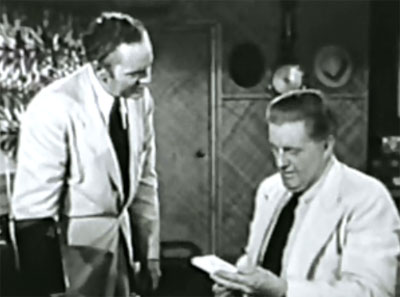
Above: Stanley Price and Gene Roth.
The brawny and athletic Marshall Reed, though billed low in the credits, plays the serial’s chief action heavy (Shark Wilson by name), and–with his size and deep voice–makes an appropriately authoritative pirate leader as well as a worthy physical opponent for Buster Crabbe. Rusty Wescoatt, Terry Frost, Pierce Lyden, and Lee Roberts–an extremely tough-looking collection of thugs–are the other principal henchmen; Roberts is killed off fairly early, but the other three remain in action throughout the serial.
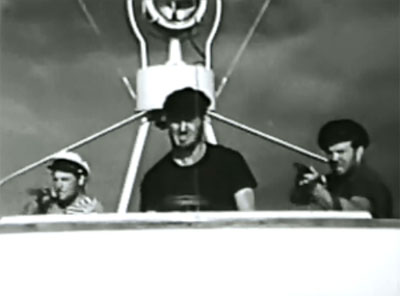
Above, from left to right: Lee Roberts, Marshall Reed, and Rusty Wescoatt on the bridge of their pirate craft.
Tristram Coffin is very good as the smooth, self-assured, and dignified secret agent Castell; Hugh Prosser also does a fine job as Crabbe’s treacherous first mate Roper–calmly and confidently trying to double-cross everyone in turn and never seeming daunted by his continual setbacks. William Fawcett is excellent as the shrewd and slightly sinister Ben Wharton, while the husky-voiced Symona Boniface gives a suitably exotic air to her turn as the enigmatic Lotus Lady.

Above: Tristram Coffin and Neyle Morrow.
Neyle Morrow plays Tommy Farrell’s likably enthusiastic native sidekick Kalana, while I. Stanford Jolley and Marshall Bradford put in brief appearances as (respectively) an island trader and an island doctor. John Hart has a small but pivotal role as the sailor murdered in the first chapter, and former serial hero Charles Quigley–in a sad comedown–plays a small part as a shady lawyer in Chapter One. Producer Katzman’s stock company of Samoan extras do double duty as a tribe of hostile natives and Gene Roth’s island police.
Pirates of the High Seas ranks as one of the most completely successful chapterplays produced by Sam Katzman during his tenure as Columbia’s serial-maker. While the production values are still ragged by comparison with Republic’s outings from the same era, its irresistible combination of interesting plotting, good performances, sure-handed direction, and novel locations makes it a very worthwhile outing nonetheless.


Good[ for a Columbia] serial. Crabbe is fun and exciting and the direction is top notch!
Katzman gets knocked a lot, and for good reason, but his serials of the late forties from Superman into the early fifties with Son of Geronimo and King of the Congo I find decently done and entertaining, with good casts. I really enjoyed this one. It might be low-budget but the on-location filming covers that. Using the actors extensively for fight scenes works for me in increasing realism. This one was well-written with a decent mystery angle, with the cast doing a fine job. Crabbe, of course, made a strong lead. ***1/2 out of *****
I REMEMBER seeing this as a kid. I REALLY ENJOYED IT THEN and STILL ENJOY IT TODAY.
My expectations going in for this serial were not very high, but it turned out to be a very pleasant surprise. It has a good cast and an entertaining storyline, and moves along a nice pace. Buster Crabbe turns in a fine performance, giving his character a believable air of cynicism amidst the heroics. The scenes involving Gene Roth and Stanley Price are especially well played. Katzman’s cheapness actually helps the serial by having the actors do much of the work in the fights, eliminating the necessity for a lot of usual doubling and making the action seem more convincing. It did seem odd that Charles Quigley accepted such an inconsequential role; I actually expected that he would turn up later and figure in the proceedings, but no such luck.
On a side note – when I lived in Long Beach, we visited Catalina a number of times so it was fun to see the island and the surrounding waters again after many years.